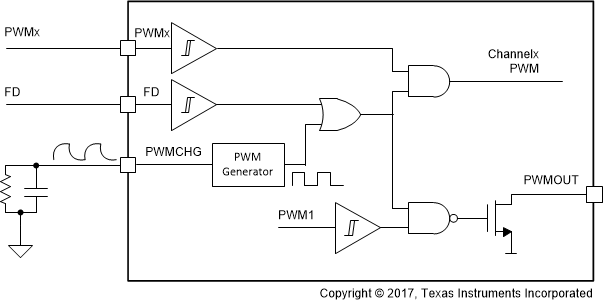SLIS178B October 2017 – January 2018 TPS92830-Q1
PRODUCTION DATA.
- 1 Features
- 2 Applications
- 3 Description
- 4 Revision History
- 5 Description (Continued)
- 6 Pin Configuration and Functions
- 7 Specifications
- 8 Detailed Description
- 9 Application and Implementation
- 10Layout
- 11Device and Documentation Support
- 12Mechanical, Packaging, and Orderable Information
Package Options
Mechanical Data (Package|Pins)
- PW|28
Thermal pad, mechanical data (Package|Pins)
- PW|28
Orderable Information
8.3.4.4 Full Duty-Cycle Switch
The TPS92830-Q1 device can flexibly switch between the internal PWM modulation mode and the 100% duty-cycle mode by using the FD input. Once V(FD) is higher than threshold VIH(FD), the internal PWM generator is bypassed and output is merely controlled by the PWM inputs.
If FD is HIGH, the PWMCHG current source is turned off and V(PWMCHG) decays to GND through the external resistor-capacitor circuit. When FD falls below the threshold, V(PWMCHG) increases from GND due to the internal charge current.
If FD is HIGH, PWM generator oscillation stops, and PWMOUT is controlled by PWM1 only.
External PWM inputs and internal PWM inputs are combined together for channel PWM dimming, or external PWM inputs can be used as channel enable inputs.
 Figure 25. PWM Dimming Internal Block Diagram
Figure 25. PWM Dimming Internal Block Diagram Table 1. Truth Table When Driving With PWM
| PWMx | FD | PWMCHG | CHANNELx PWM |
|---|---|---|---|
| LOW | X | X | LOW |
| HIGH | HIGH | X | HIGH |
| HIGH | LOW | R-C | PWM generated with RC |
Table 2. Truth Table When Driving With PWMOUT
| PWM1 | FD | PWMCHG | PWMOUT |
|---|---|---|---|
| LOW | X | X | LOW |
| HIGH | HIGH | X | HIGH |
| HIGH | LOW | R-C | PWM generated with RC |